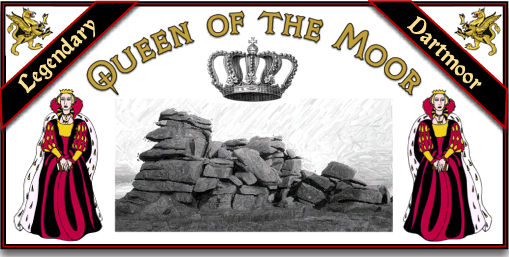
The ‘Queen of the Moor’ is a majestic tor high in the wastes of the northern fen where she rules over all she surveys. The ‘Queen of the Moor’ is commonly know as Fur tor and comprises of several outcrops. Many will argue that this is the remotest tor on Dartmoor and standing at a windswept 1, 776.6ft (572m) few will disagree. According to the topographical writers Fur tor derives from a blend of the Celtic; Vwr – great and twr – tower thus giving Vur tor which is the recognised moor name. There is also a suggestion that the name has hardly been corrupted and simply derives from the Saxon/Celt mix of Feor – far and twr – tower which arrives at Fur tor. However Gover et al, 1992, p.198 suggest that the name derives from the Old English fierra and the Medieval English furre both meaning ‘further’ which could possibly refer to its remoteness.

Hemery, pp. 970-1 expertly describes the tor: “Several rock-piles stand on the extensive summit plateau. The main, centre pile contains a rock chimney, the sides of which pincer-like have arrested the fall of a huge slab. Mrs Bray writes in Tamar and Tavy of the “(rock) basin 2½ feet in diameter and eight inches deep. There, also, are two small contiguous basins, one of which has a perforation communicating with the side of the rock” … The fine west pile casts an enormous clitter to the level of Vur tor plain; it moved down the slope in a vast, dense mass rather than in rock-streams, many of the rocks being as large as motor cars. The east pile had clittered the slope above Cut Combe across which it faces the mountain of Cut. The existence of Vur tor in the midst of an otherwise tor-less wilderness of fen is a phenomenon, all the more remarkable for its magnificence.”
Samuel Rowe, 1985, p.218 gives a very evocative description of Fur tor and its surroundings when he says:“Furtor is the most isolated of the Dartmoor heights, and to signify the ‘far’ tor is appropriate enough for a summit and its name, which seems to retain the old English ‘feor,’ which is the most remote and difficult to access of any on Dartmoor. The peat moors which surround it, represent the decay of past ages – silent, dreary, lifeless – rarely visited during the greater part of the year, but by a wandering hill fox – the true ‘dysart of ‘Dertymore,’ as the natives call it.”
There are several names of places around the tor which do not appear on the OS map and are shown below:
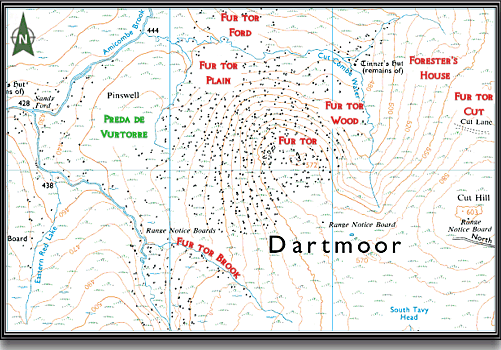
It may seem strange to see ‘Fur tor Wood’ in the middle of the fen and it is actually a small bog but it appears that at one time there may have been trees growing there, Crossing, 1990, p.170 states, “The name seems to point to the former existence of trees in this sheltered hollow, and the discovery a few years ago of oak buried in the peat near Little Kneeset proves that they once grew around here.”
Fur tor Cut is an old name by which the moormen knew Cut Lane by and it is a centuries old track or pass used by them to move cattle across the Fen. For centuries the ground around Fur tor has been renown for its good grazing and so has been favoured by the moormen to pasture their cattle and ponies. There is a very early account of John D’Abernon, the Constable of Lydford, where he lists the people who had put cattle in the Forest to pasture. Included amongst the named places in the northern quarter was Preda de Vurtorre. Preda is an old term for areas of good grazing and today is more commonly known as a ‘lair’, Crossing, 1987, pp28-9.
The ‘Forester’s House’ is marked on the early maps as a ‘Hut Circle‘ and is the ruins of a small circular shelter, but in Hemery’s, p.966, opinion it was in fact a Foresters hut. This would have been associated with the Dartmoor Foresters of old hence the name ‘Forester’s House’. These were men who job it was to protect the king’s deer from poachers, in 1301 there were six Foresters on the moor. It seems that the graziers were prone to a spot of poaching and so in 1354 the Black Prince decreed that whilst the deer calves were at risk from poaching the Foresters should continually live on the moor. This then led to the building of small sturdy shelters or ‘houses’ in which the Foresters would live, Hemery, p50. Butler, 1991, p.111, has very little to say about the structure apart from, “The foundations of the building are only roughly rectangular (c. 2.0 x 3.0m) with an entrance on the north side,” he however list it under the heading of “Tinning.”
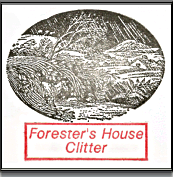
Letterbox Stamp from Forester’s House
Hemery describes the western rock stream as having boulders as big as “motor cars,” and that is no understatement. Some of them form large caves which have been named by the letterboxers such as the ‘Bat Cave’ which at one time had several boxes concealed in it. Many regular walkers hide caches of food and drink in their own ‘caves’ and every time they were passing on a day walk the ‘larder’ is topped up. The reasoning for this is that if they are ever camping near the tor there is no need to carry a rucksackful of supplies thus reducing the load.
Fur tor is also another place where there is a recognised letterbox and visitor’s book, although it is no longer marked on the Ordnance Survey maps. If it has not been stolen it can usually be found on the western side of the main stack. In 1957 the Plymouth Boy Scouts Association sited a stamp and various ones have been placed there ever since, one called “Fur tor – Queen of the Moor.” Below is a copy of the official Fur tor stamp and a copy of a letterbox stamp I sited, it is called ‘All the Two’s’ because the 100 club registration number for the box was 22,222.
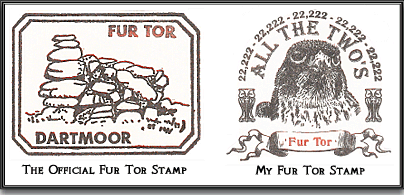
The tor is also the destination for the ‘New Years Day Meet’ which is an annual event that has been held since 1981. Ramblers and Letterboxers walk out to Fur tor early on the 1st of January then at lunchtime they all meet up for some festive cheer, letterboxing and a group photograph. It is an excellent way to walk off some of the Christmas indulgencies.
Hemery, relates a story of when he was guiding moor visitors, it appears that a Cornish ‘mystic’ and her friend wanted to be taken to Vur tor. The morning of the walk saw a wet and very misty day. Hemery advised against the trip but the woman was adamant and asked to be taken to a vantage point where the whole of Vur tor could be seen in normal visibility. The party went to such a point albeit the mist had not lifted and the tor was engulfed in fog. The ladies knelt down and made the sign of the cross and just waited looking expectantly into the murk. After a couple of minutes the veil parted and rolled up the valley towards Vur tor once it had reached the tip of the granite mass rays of sunlight momentarily bathed the tor in sunlight, the ladies watched and then the mist rolled back down obscuring the vista. The mystic also told Hemery that in her opinion a great, elemental being keeps watch over the tor and it has become dormant and needs spiritually awakened.
Back in 1868 a small six year old girl who lived near the Dartmoor Inn went missing. It was her job to fetch their horses in from the nearby common each day and one morning she set off from home at eight o’ clock when a thick fog descended. Somehow she managed to lose her way and became disoriented and wandered aimlessly trying to find here way home. Once it was discovered she was missing a search was mounted throughout that day but there was no sign of her. When darkness descended the search was called off and resumed the next day which miraculously she was found close to Fur Tor. Despite having wandered some six miles and spent the night exposed to a sharp frost she seemed remarkably fit and well.
Probably one of my most memorable visits to Fur tor was in the late 90’s. The ‘Dartmoor Drifter’ had sited a new box on Fur tor called ‘The Fiery Spirit’ and as a bonus there was a bottle of whisky for the first person to find the box. The clue was a cryptic one that mentioned a quote in a Dartmoor book which referred to a tor where the huntsmen partook of the ‘fiery spirit’, if you knew the the line you could work out where the box was. Luckily, after days of research I found the quote in Hemery’s book – High Dartmoor, p. 917, where in the description of Fur tor he wrote, “The capacity of the old-time huntsman for quaffing fiery spirit without impairing his equestrian skill was truly astonishing.” At one time the local hunt used to hide stashes of whisky on the tor in order that they could partake in a swift ‘nip’ whenever they were in the area. The challenge was on, it was mid-week when I received the clue and so I took a ‘sickie’ and headed off for Fur tor. Such was my haste that I forgot to check the firing times and it was not until I got on the moor that I realised the range was shut. Dilemma, continue on or whimp out, the lure of the fiery spirit was too much, by the time I reached Fur tor it was a battlefield. Helicopters, men, smoke and loud bangs were everywhere and I am sure I heard things whizzing above my head. The main problem was to avoid the eagle eyes of the range wardens and this meant slinking through the huge boulders. I did find the box and much to my disappointment I was the second person and beaten by a day – such is the fun of letterboxing.
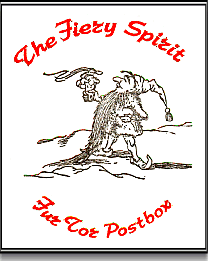
The elusive stamp.

Butler, J. 1991 Dartmoor Atlas of Antiquities, Vol. II, Devon Books, Exeter.
Crossing, W. 1990 Crossing’s Guide to Dartmoor, Peninsula Press, Newton Abbot.
Crossing, W. 1987 Gems in a Granite Setting, Devon Books, Exeter.
Gover, J. E. B., Mawer, A. & Stenton, F.M. 1998 The Place-Names of Devon. The English Place-Name Society, Nottingham.
Hemery, E. 1983 High Dartmoor, Hale Pub., London.
Page, J. Ll. W. 1895 An Exploration of Dartmoor, Seeley & Co., London.
Rowe, S. 1985 A Perambulation of Dartmoor, Devon Books, Exeter.
 Legendary Dartmoor The many aspects past and present of Dartmoor
Legendary Dartmoor The many aspects past and present of Dartmoor

I wonder if this “great elemental being” the mystic sensed guarding the tor is the nature of the “Hairy Hands” phenomena.